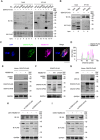Diacylglycerol O-acyltransferase 2, a Novel Target of Flavivirus NS2B3 Protease, Promotes Zika Virus Replication by Regulating Lipid Droplet Formation
- PMID: 39449854
- PMCID: PMC11499588
- DOI: 10.34133/research.0511
Diacylglycerol O-acyltransferase 2, a Novel Target of Flavivirus NS2B3 Protease, Promotes Zika Virus Replication by Regulating Lipid Droplet Formation
Abstract
Various lipid metabolism-related factors are essential for Zika virus (ZIKV) replication. In this study, we revealed a crucial role of diacylglycerol O-acyltransferase 2 (DGAT2) in ZIKV replication using a short hairpin RNA-based gene knockdown technique. The replication of ZIKV was significantly inhibited by DGAT2 depletion in multiple cell lines and restored by trans-complementation with DGAT2. Mechanistically, DGAT2 is recruited in the viral replication complex by interacting with non-structural (NS) proteins. Among them, both human and murine DGAT2s can be cleaved by NS2B3 at the 122R-R-S124 site. Interestingly, the cleavage product of DGAT2 becomes more stable and is sufficient to promote the lipid droplet (LD) formation independent of its enzymatic activity. This work identifies DGAT2 as a novel target of the viral protease NS2B3 and elucidates that DGAT2 is recruited by viral proteins into the replication complex, thereby playing a proviral role by promoting LD formation, which advances our understanding of host-flavivirus interaction.
Copyright © 2024 Xiaotong Luo et al.
Conflict of interest statement
Competing interests: The authors declare that they have no competing interests.
Figures







Similar articles
-
Inositol-Requiring Enzyme 1α Promotes Zika Virus Infection through Regulation of Stearoyl Coenzyme A Desaturase 1-Mediated Lipid Metabolism.J Virol. 2020 Nov 9;94(23):e01229-20. doi: 10.1128/JVI.01229-20. Print 2020 Nov 9. J Virol. 2020. PMID: 32967957 Free PMC article.
-
The triglyceride-synthesizing enzyme diacylglycerol acyltransferase 2 modulates the formation of the hepatitis C virus replication organelle.PLoS Pathog. 2024 Sep 6;20(9):e1012509. doi: 10.1371/journal.ppat.1012509. eCollection 2024 Sep. PLoS Pathog. 2024. PMID: 39241103 Free PMC article.
-
Double-stranded RNA deaminase ADAR1 promotes the Zika virus replication by inhibiting the activation of protein kinase PKR.J Biol Chem. 2019 Nov 29;294(48):18168-18180. doi: 10.1074/jbc.RA119.009113. Epub 2019 Oct 21. J Biol Chem. 2019. PMID: 31636123 Free PMC article.
-
The role of DGAT1 and DGAT2 in regulating tumor cell growth and their potential clinical implications.J Transl Med. 2024 Mar 18;22(1):290. doi: 10.1186/s12967-024-05084-z. J Transl Med. 2024. PMID: 38500157 Free PMC article. Review.
-
Inhibition of Diacylglycerol Acyltransferase 2 Versus Diacylglycerol Acyltransferase 1: Potential Therapeutic Implications of Pharmacology.Clin Ther. 2023 Jan;45(1):55-70. doi: 10.1016/j.clinthera.2022.12.008. Epub 2023 Jan 21. Clin Ther. 2023. PMID: 36690550 Review.
Cited by
-
Subcellular determinants of orthoflavivirus protease activity.J Biol Chem. 2025 Jul 5;301(8):110451. doi: 10.1016/j.jbc.2025.110451. Online ahead of print. J Biol Chem. 2025. PMID: 40619004 Free PMC article.
References
-
- Rasmussen SA, Jamieson DJ, Honein MA, Petersen LR. Zika virus and birth defects--Reviewing the evidence for causality. N Engl J Med. 2016;374(20):1981–1987. - PubMed
LinkOut - more resources
Full Text Sources
Research Materials
Miscellaneous

